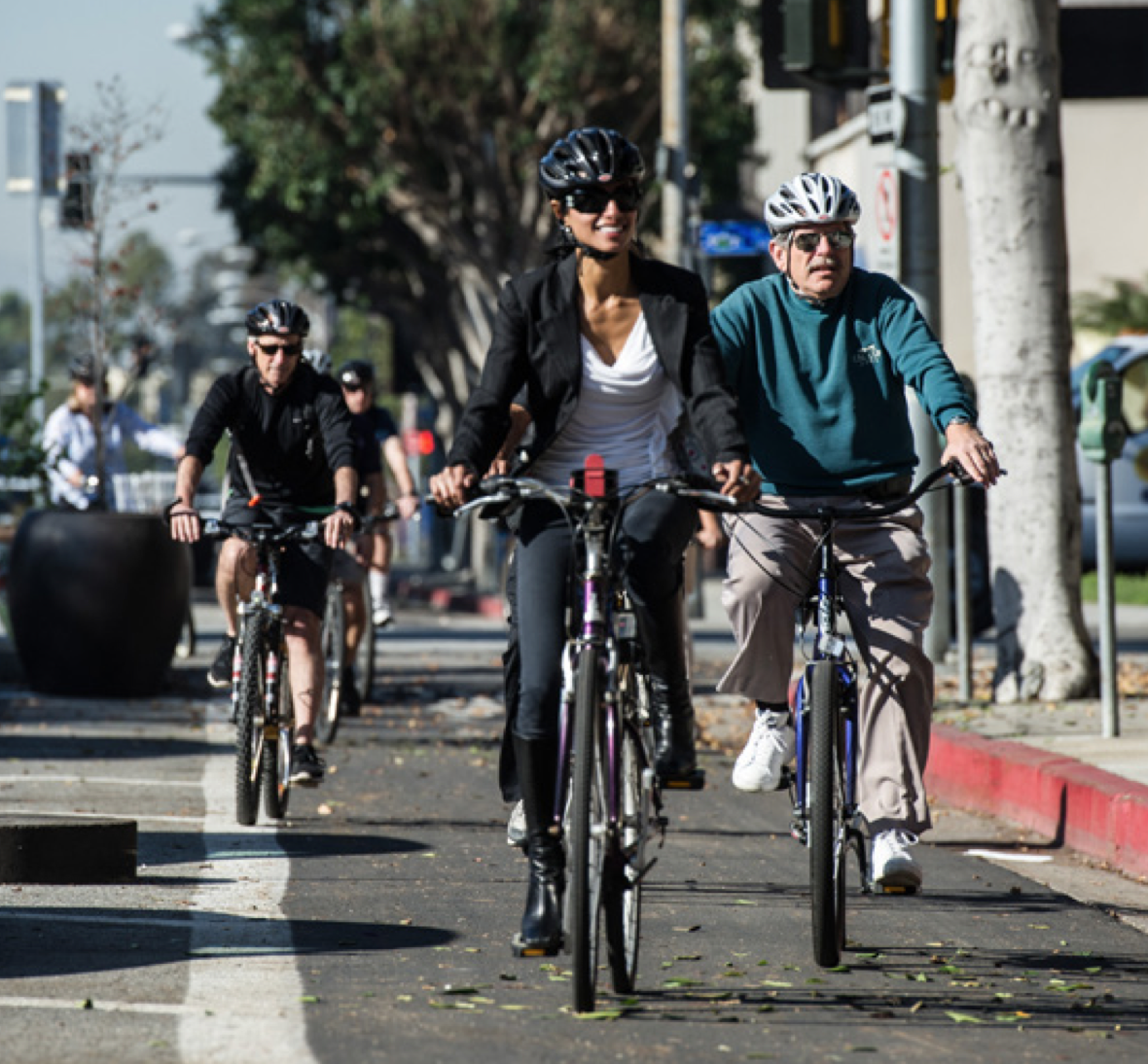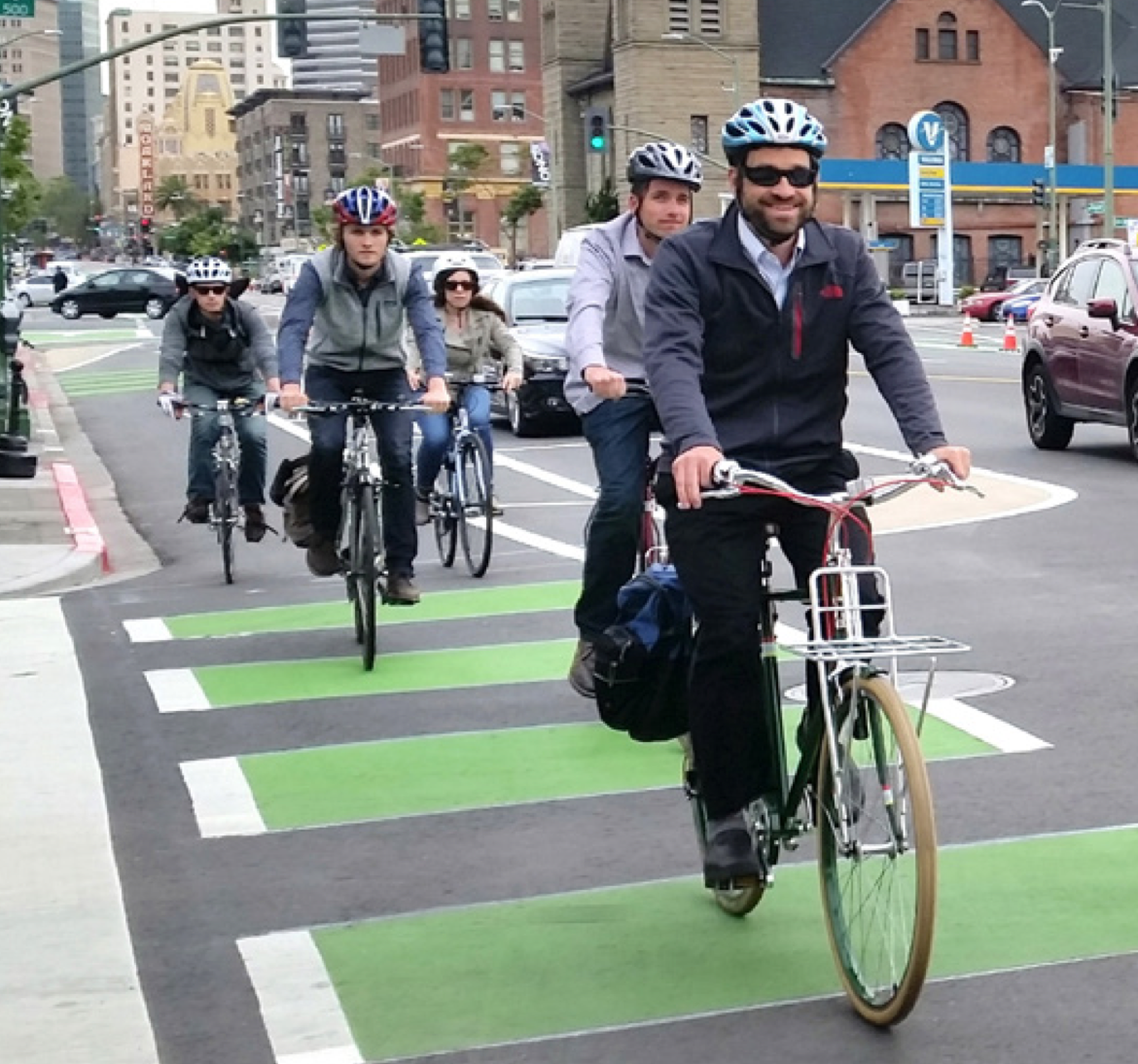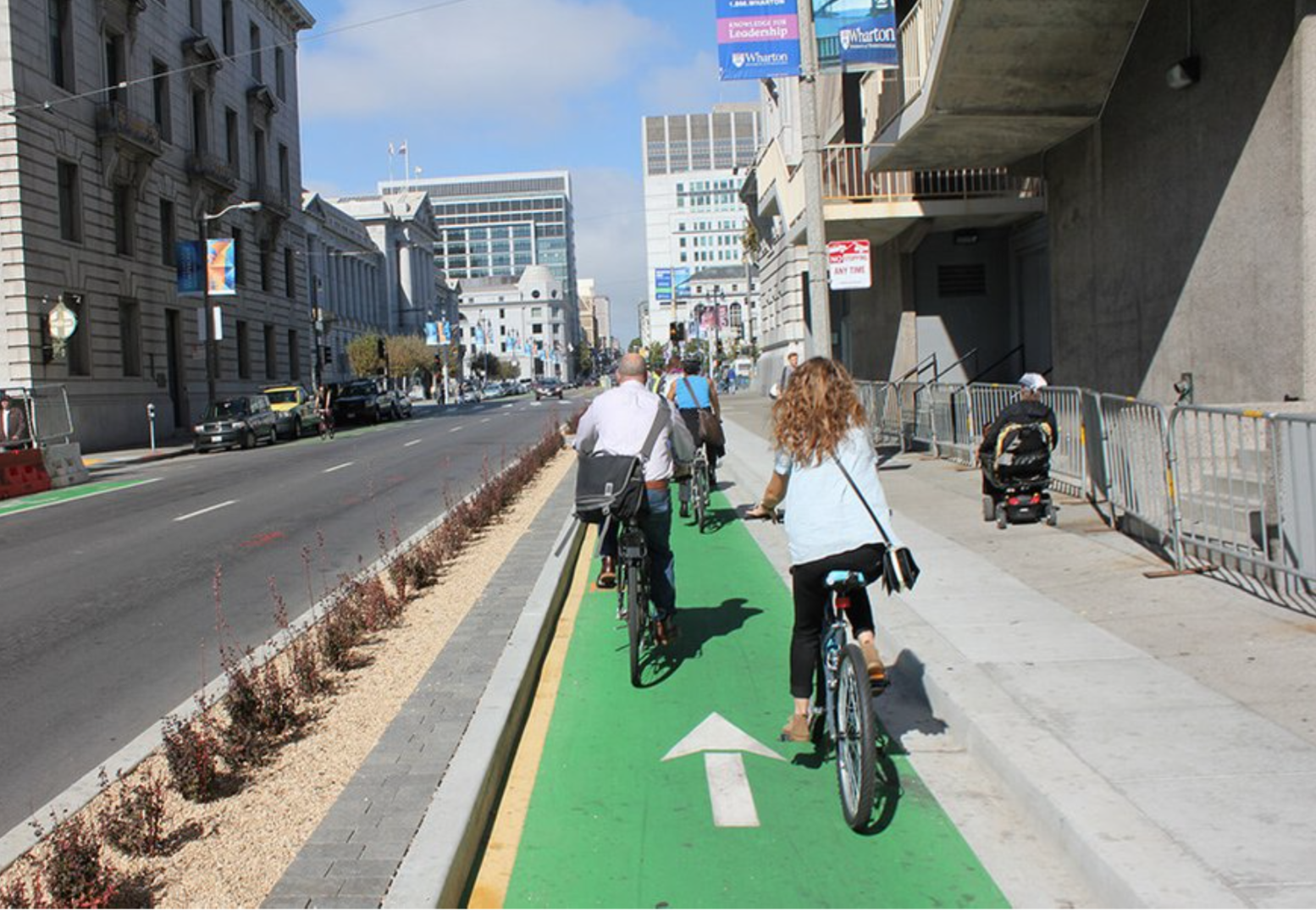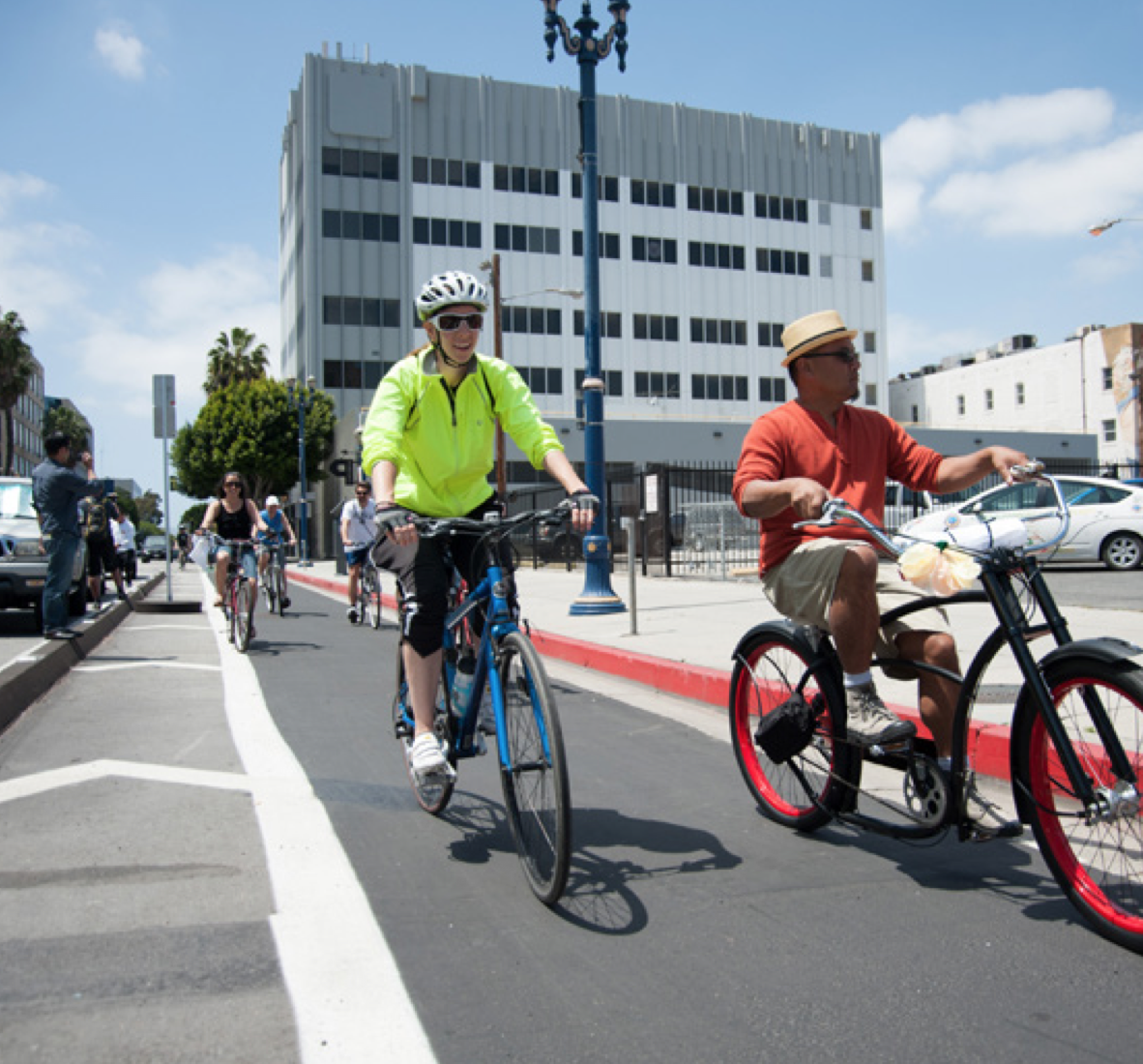Protected bike lanes are good for everyone
Protected bike lanes are relatively new in the United States. For this reason, not everyone knows why they are so helpful for so many people. The fact is, research and experience shows again and again and again the same thing: protected bike lanes are good for everyone. In a 2018 report, Calbike notes that protected bike lanes:
“Improve safety for bicyclists, drivers, and pedestrians”
“Increase sales in business districts”
“Boost property values”
“Get more people to ride bikes by providing the safety, comfort, and separation most people want and need to consider bicycling”
Below, we take a deep dive into a few facts and common concerns about protected bike lanes. At the bottom of this article, we provide twenty supporting references that informed our understanding.





Protected bike lanes improve street safety for everyone
Here’s an important fact about protected bike lanes: they are not just for cyclists! Whether using a street to drive, walk, or bike, everyone benefits from clear rules and a well-organized road. Protected bike lanes separate cars from bikes, creating a smoother environment for people in cars, who can drive more easily and more safely without needing to wait behind - or pass - people on bicycles.
Repeated studies consistently show that adding a protected bike lane to a road improves safety for all road users - including drivers, walkers, and bikers. Research shows that adding protected bike lanes reduces all collisions and injuries by 30-50%. The reason is simple: roads are easier to navigate when everyone is in their place. There can only be peace on the road, when everyone has a piece of the road.
Because all available research shows that adding a protected bike lane increases safety, we believe that this is an important fact to consider when comparing options with and without bike lanes. The idea that bike lanes only protect people on bicycles is misinformation. DOT should highlight safety implications for all road users when considering designs with protected bike lanes.
Protected bike lanes are good for business
Walking or biking to shop and dine is fun and popular, and nearly everyone prefers to shop in areas that feel safe. If we want businesses to thrive, we need business-oriented streets to include safe areas for walking and rolling. Research consistently shows that people patronize shops and restaurants more often when they are walking or biking. Building a protected bike lane on commercial corridors attracts these high value customers, creating larger profits for businesses along the street. In fact, dozens of research studies have come to the same conclusion: adding a protected bike lane to a street either increases business or has no impact. Cases where adding protected bike lanes created negative impacts for businesses appear to be virtually non-existent. The idea that adding protected bike lanes may harm businesses is misinformation.
Protected bike lanes can be compatible with ADA requirements
The Americans with Disabilities Act (ADA) is an important federal law that guarantees persons with disabilities access a range of businesses and services. Any street design must consider the needs of this population, and be compliant with this legislation.
Fortunately, cities all over the country are currently designing and building ADA compliant bike lanes. Designs for ADA compliant protected bike lanes are available to replicate, and a number of cities have published guides that specifically address this issue, showing city staff and contractors how to design streets that are both safe and ADA compliant.
After Pasadena DOT staff expressed concern about building ADA-compliant bike lanes, PasadenaCSC volunteers attended a training on ADA compliance, and asked an expert about the issue. Cathy Ly, who is the CalTrans Civil Rights Coordinator, explained what’s written above: ADA compliant designs for protected bike lanes are well understood, and even recommended some specific guides. If you like, you can hear her answer at time-stamp 1:27:12.
Protected bike lanes are not only compatible with ADA requirements, but in many cases, they are beneficial for some people with disabilities. Of course, people with different abilities have different needs. In many cases, people with disabilities are unable to drive, but are able to use wheeled mobility, like electric scooters, bicycles, recumbent bikes, or electric wheelchairs. All of these individuals are able to use bike lanes as a safe way to travel. In addition, because protected bike lanes order the roads and reduce all collisions, anyone crossing a street or using the sidewalk - especially vulnerable road users - benefits from the added safety of a protected bike lane.
All this leads us to conclude that protected bike lanes can be compliant with all state and federal ADA protections, and that they improve access for a diverse group of people with a large range of abilities.
Summary
The vast majority of available research shows that protected bikes improve safety for all street users, including pedestrians and drivers, while providing critical support for businesses. The facts show that protected bike lanes make cities safer, increase business sales, and are ADA compatible. We ask that government and city staff include these facts when evaluating any future proposals for street design.
References
Protected bike lanes are good for business
Business Insider surveyed 32 research articles, proving bike lanes are good for business Business Insider, “Bike Lanes are good for business” , 2024
Customers who walk or ride to shops visit more often and spend more money. The Clean Air Partnership, 2010 -Bike Lanes, On-Street Parking and Business: Year 2 Report
On Salt Lake City's Broadway, replacing parking with protected bike lanes increased retail sales. Salt Lake City Department of Transportation - Salt Lake City Department of Transportation
Protected bike lanes can be part of street redesigns that greatly boost retail performance. After the construction of a protected bike lane on 9th Avenue, local businesses saw a 49 percent increase in retail sales. On other streets in the borough, the average was only 3 percent. NYC DOT, 2012 - Measuring the Street
In a national study of 14 corridors that received improvements for active transportation, street improvements had positive or non-significant impacts in all cases - People for Bikes, Bennett Midland, Portland State University, and The Summit Foundation, 2020 , National Study of the Economic Impact of Street Improvements
A redesign of NYC's Union Square to include a protected bike lane resulted in 49% fewer commercial vacancies, compared to 5% more throughout Manhattan. NYC DOT, 2012 - Measuring the Street
New research from Portland State University finds that proximity to a network of high-quality bike facilities such as protected bike lanes, buffered bike lanes, and bike boulevards, is associated with an increase in property values.
Liu, J., Shi, W., 2016 - Impact of Bike Facilities on Residential Property Prices
The Urban Land Institute recently published a series of findings linking economic development with bicycling in the U.S. and globally. For example, the Indianapolis Cultural Trail cost the city $62.5 million to build and yielded a $1.01 billion increase in property values adjacent to the trail. Urban Land Institute, 2016 - Active Transportation and Real Estate
“[Studies] all reach a similar conclusion: replacing on-street parking with a bike lane has little to no impact on local business, and in some cases might even increase business.” The Complete Business Case for Converting Street Parking Into Bike Lanes: An annotated, chart-filled review of 12 studies from around the world. by Eric Jaffe, Bloomberg CityLab (2015)
“Parking kills businesses, not bikes or buses” by Dr. Timoth F. Welch, Newsroom (2021)
Protected bike lanes improve safety for everyone
New York City's protected bike lane on 9th Avenue led to a 56 percent reduction in injuries to all street users, including a 57 percent reduction in injuries to people on bikes and a 29 percent reduction in injuries to people walking, as well as an 84 percent reduction in sidewalk riding. NYC DOT, 2012 - Measuring the Street
When protected bike lanes are installed in New York City, injury crashes for all road users (drivers, pedestrians, and cyclists) typically drop by 40 percent and by more than 50 percent in some locations. Wolfson, H., 2011 - Memorandum on Bike Lanes, City of New York, Office of the Mayor, 21 March 2011
Streets with protected bike lanes saw 90 percent fewer injuries per mile than those with no bike infrastructure. Teschke, K., et al., 2012 - Route Infrastructure and the Risk of Injuries to Bicyclists: A Case-Crossover Study
Streets with protected bike lanes saw 28 percent fewer injuries per mile than comparable streets with no bike infrastructure. People were also 2.5 times more likely to bike on the protected lanes than in general travel lanes. Lusk, A., et al., 2010 - Risk of injury for bicycling on cycle tracks versus in the street, Injury Prevention, December 1, 2010
80 percent of people who live near a protected bike lane project believe it increased safety on the street. Monsere, C., et al., 2014 - Lessons from the Green Lanes (National Institute for Transportation and Communities)
After New York City installed a protected bike lane on Columbus Avenue, bicycling increased 56 percent on weekdays, crashes decreased 34 percent, speeding decreased, sidewalk riding decreased, and traffic flow remained similar New York City Department of Transportation, 2011 - Columbus Avenue parking-protected bicycle path preliminary assessment
Because they shorten crossing distances, control turning conflicts and reduce traffic weaving, New York City's protected bike lanes reduced injury rates for people walking on their streets by 12 to 52 percent. NYCDOT, 2013 - It turns out that protected bike lanes are fantastic for walking safety, too
Where protected lanes were installed in New York and Washington D.C., the number of bikes on sidewalks immediately fell by an average of 56 percent. NYCDOT and DDOT, 2010-2014 - Tired of Cyclists Riding on the Sidewalk? Build More Bike Lanes
Study Finds Protected Bike Lanes Increase Traffic Safety for Everyone-Including Drivers by John Lloyd (2021)
Protected bike lanes can be ADA compliant
Separated Bike Lane Design Guide, United States Federal Highway Administration
Separated Bike Bike Lane Design Guide, Massachusetts Department of Transportation
CalTrans ADA Training - Discussion of ADA compliant bike lanes is in the September 28th event, at time stamp 1:27:12
“New report on how to design protected bike lanes that keep pedestrians safe”, by JODIE MEDEIROS (2019)
“Getting to the Curb: A Guide to Building Protected Bike Lanes That Work for Pedestrians”, Walk San Francisco (2019)
“ADA-compliant protected bike lanes” by Annie Van Cleve (2014)
Notes
Many references and reference notes in this article are adopted from research by People for Bikes. Images adopted from a 2018 report by the California Bicycle Coalition, “Class IV Separated Bikeways: Approved for Use in California”
